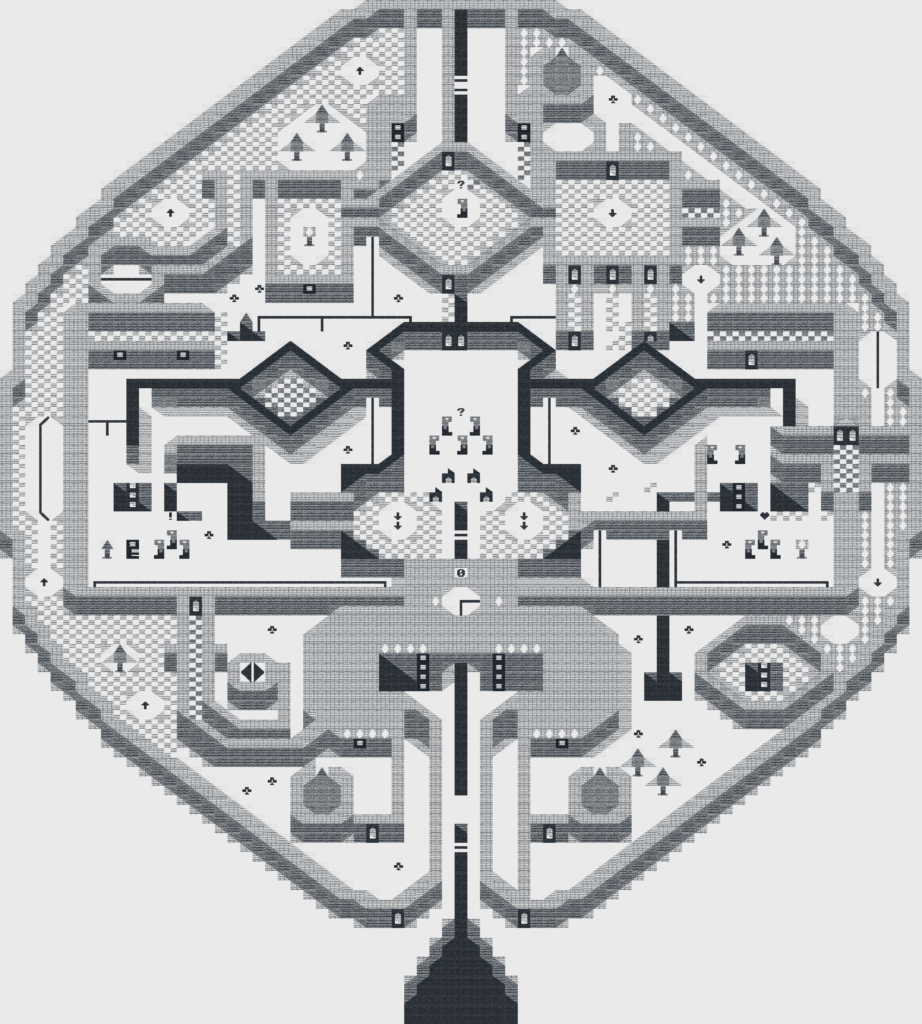
On July 25th, a series of releases from the Saudi press agency announced plans to create a linear megacity called “The Line”, part of the Saudi state’s NEOM project, a legal and economic special area in northwestern Saudi Arabia. Visualizations of the project had already been disseminated in various forms in 2021– they depict a towering wall-like structure mirrored on either side. The structure is both a wall and a mirage, promising to disappear into the surrounding desert, creating a utopia for humans (and a dystopia for birds). The press releases promised, like many in a long lineage of visionary architectural projects, that The Line would be environmentally harmonious, “a zero carbon city” (Reuters 2022). Such estimations naturally overlook the impact of the accumulated 100 to 200 billion dollars of petrochemical profits that would be funneled towards the Line’s creation. 3D modeled promotional videos posted online for the project could be easily mistaken as a stealth advertising campaign for a videogame–in one video an actress escapes from a gray and polluted urban wasteland, leaping into The Line’s gleaming eco-mall interior, where she is granted the power of flight. Nine million people will be able to live in the structure without needing cars, the video extolls. As I was watching these videos, my own visionary megastructure was collapsing, again–an intricate, vertically stacked city wrapped around a central shaft, filled with temperamental fantasy dwarves. This is a city built in the videogame Dwarf Fortress. I had started building my fortress as the pandemic lurched into its second year, slipping from a temporary emergency into a seemingly permanent fixture of the increasingly inhospitable world outside. Inside Dwarf Fortress, a plumbing disaster, a series of overly ambitious construction projects, and a handful of preventable dwarf-deaths had sent my dwarves into enough of a spiral of rage and depression that they had put down their picks and refused any further work.

https://www.neom.com/en-us/regions/theline
Dwarf Fortress is a particularly fascinating civilization simulation game. It has a notoriously steep learning curve and minimal graphics (in its base configuration, everything in the game world is represented by letters and glyphs on a matrix–an array of such matrices symbolizes levels of elevation in a space that stretches from sky to magma)*. Every in-world item, character and location can be inspected by the player, revealing generated, detailed text descriptions. Playing the game can involve an awkward juggling of menus that initially feels like building a ship-in-a-bottle by navigating a series of tax forms, but for those with the patience to learn it, Dwarf Fortress is uniquely generative and dizzyingly deep. The player guides the building of a civilization of dwarves inside a procedural simulation of a randomly seeded world. Each game world is unique, with potentially thousands of years of generated history, civilizational clashes, trade relations, and the formicine teeming of nature across a fractal terrain of varied biomes. The game, while taking on a set of obligatory Tolkienesque fantasy tropes (here there are civilizations of elves, humans, goblins, and dwarves) as its starting point, leaves all subsequent world events entirely to the interplay of the simulation and the player. Everything that occurs, every name and detail down to the eye color of a single river trout, is generated by the game. This is taken to unheard-of extremes–I’ve watched dwarves invent, and through recitation evolve, named modes of poetry, music and dance, each with (sometimes lengthily) described formal elements. Every detail of the dwarves’ culture and production (down to what sort of rendered fat or plant oil they are making individual bars of soap from) is modeled and running within in the simulation. Most importantly, every individual dwarf citizen has likes and dislikes, a history of in-game experiences that modifies their personalities, detailed relationships with other individuals, and resulting states of mental and physical health, all of which can be read and reacted to, dwarf-by-dwarf.
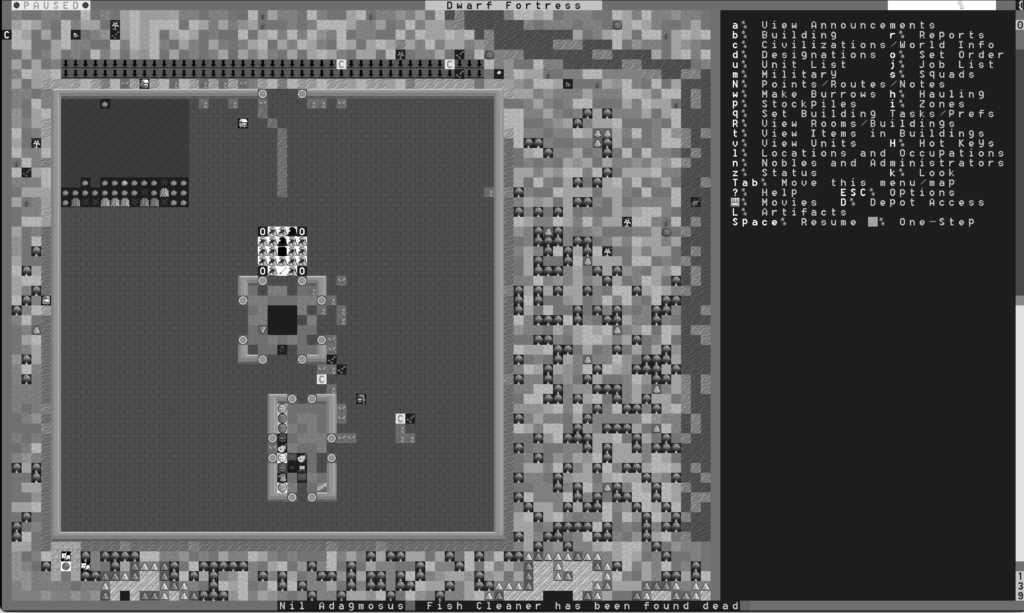
The game, developed by a pair of brothers, Tarn and Zach Adams, over the course of two decades, was selected by the Museum of Modern Art for a recent exhibit on games, and has been the subject of a handful of academic papers. I picked up the game after a play lesson over coffee from a professor who had taught a course based around Dwarf Fortress. Ever since, I’ve found that I return to periods of intense play when I am stressed or feel otherwise out of control of my life. It helps to recenter me, even when a play session ends in disaster. What stands out most is how singular Dwarf Fortress is in what I call its mode of game-world apprehension and how that mode encourages experimentation and the conception of a unique game-self. By “game-world apprehension” I mean the manner in which the world constructed by the game is understood through the process of experimentation, not just the player’s visual perspective. Through experimentation in a game, we intuit not just a designed world and its principles (and embedded ideologies); we also imagine a game-self within that world, through which our actions are carried out. Other simulation and strategy games have very different structures and embedded ideologies and construct very different game-selves for the player. SimCity (1989), for example–one of the earliest and most iconic simulation games–presents itself as an open urban construction set, but is built on rigidly normalized ideas of what does and does not create effective cities or happy citizens. In his talk at the first International City Gaming Conference in Rotterdam, game artist and critic Paolo Pedercini described SimCity as promising endless possibilities to create a dream city, but in reality, always producing “something that looks like Phoenix Arizona” (Pedercini 2017). For its 2013 iteration, SimCity’s designers did research on real cities to try to model them correctly, but found that they had to vastly under-represent the area covered by parking lots in a modern city or the game terrains would resemble one vast parking lot (Twilley 2013). Nation-building strategy games like Sid Meier’s Civilization series also enshrine ideologies about technological progress, the inevitability of capitalism and zero-sum competition between nations. The Civilization series are Risk-like games of militaristic and cultural domination that result in a victor and losers. As McKenzie Wark observed of the fifth game in the Civilization series in her book Gamer Theory, “You can change the form of government but there’s not much you can do to change the underlying form of production” (Wark 2007). By contrast, SimCity’s various iterations are open-ended games, but their implied success-state is one of maximum optimization and growth of individual city-blocks, sewn together in a car-connected sprawl. Player agency in these games is generally managed by the scarcity of a defined energetic resource (usually money, often mined from the ground with a baked-in exchange value, as if it were a feature of the physics of the universe). Production is simply an action of money in such games, labor does not functionally exist, and scarcity is reinforced as implicit. The player-character is a sort of god, kept in check only by the depths of their wallet.
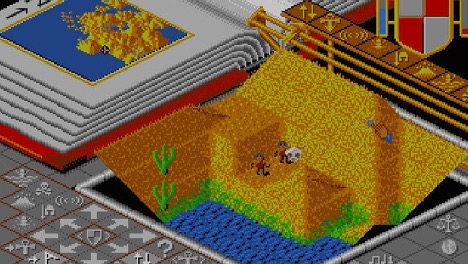
In Peter Molyneux’ 1989 game Populous, the player assumes literally the role of a god who generates potential energy from worshippers, with increasing power to directly modify the landscape as the number of worshippers increases. The God-player of Populous peers down at the isometric landscape of the game world as at a page of a magical book. While Civilization suggests an individual political leader as the player’s game self, the SimCity series suggests some undefined hybrid of mayor and all-powerful unchecked urban planner/construction firm (perhaps a suburban crown prince?). Like these games, in Dwarf Fortress the player is not represented as an individual character in the game itself. But unlike other simulation games, the will of the player is carried out by individual dwarves who must be fed, housed, provided with alcohol (yes, they like to party), intellectually stimulated, and kept in touch with peers and family, or they simply do not work. Robbie Fordyce sums up this level of agency and its potentials succinctly in his article “Dwarf Fortress: Laboratory and Homestead” for the journal Games and Culture –
How do we understand the role of the player in the game of Dwarf Fortress? The player acts to coordinate resources so as to best serve the psychic requirements of the community. Warding off insanity among the most emotionally precarious dwarves is, for all pragmatic concerns, the only loss condition for the game. To this end, the player is not a transcendent entity who utilizes a hierarchy of command in order to succeed, despite the cues of the strategy games genre, they also do not take the role of a ‘‘focalizer’’ for action, such as within character-driven games… Instead the player is the genius loci of the community, a deity that develops out of the community itself, which, and I cannot emphasize enough, is expressly not an idea of the transcendent ‘‘invisible hand’’ in any of the myriad permutations drawn from Adam Smith. This position points to the two primary concerns for this article: First, the totally immanent nature of the ordering of the community’s labor and resources and second, the lack of a transcendent economic hierarchy leads to a completely free space for the processes of laboratory experimentation.
(Fordyce 2018, 10)
Action in the game isn’t a function of money (to the dwarves, gold is just a shiny metal, liked or disliked as any other building material†) it’s the movement of a highly complex and healthy city-as-organism and city-as-laboratory. This form of play operates within different parameters than the “God mode” of other simulation games. This difference goes beyond level of agency, as the quality of that agency is set by a system of which the player is a part, rather than its primary mover.
From Arcology To The Arcology Mode Of Play
Social media responses to the Saudi Line press release included references to SimCity and Civilization, demonstrating that the link between visionary megastructures and games is already strong in the popular consciousness. Adding Dwarf Fortress to the conversation changes things though: by virtue of breaking down what is backgrounded as implicit in other games of nation building, Dwarf Fortress exemplifies a mode of play that I call the “Arcology mode”.
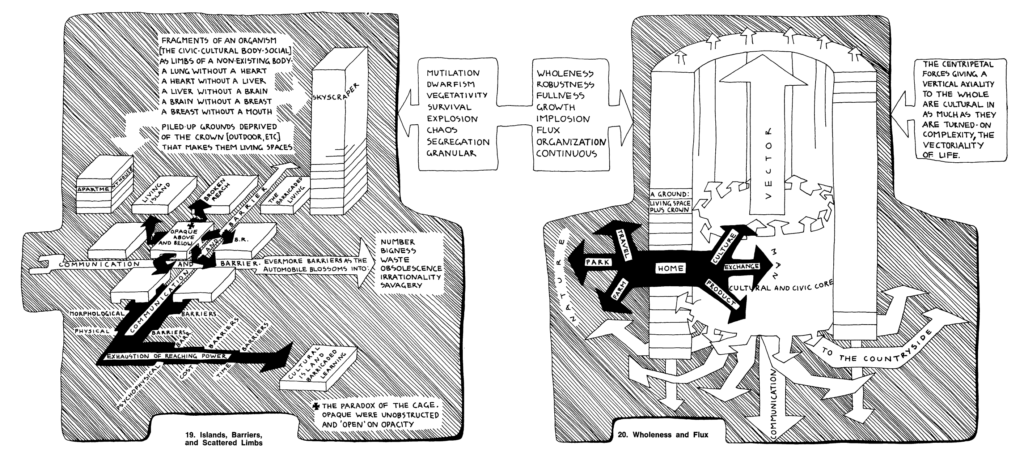
Arcology, a portmanteau of “architecture” and “ecology” was coined by artist-architect Paolo Soleri to describe his visionary architecture of environmentally regulated city-megastructures (Soleri 1970). An arcology was a “three dimensional” city, densely populated, growing up rather than merely out. Soleri believed that reducing the footprint of such structures, combined with passive heating and cooling and the use of renewable energy sources, would reduce the environmental impact of large cities. Soleri’s sketches towards his arcology projects included much more than architectural forms; they made sweeping theoretical proclamations about connections between society, culture, technology, and self.
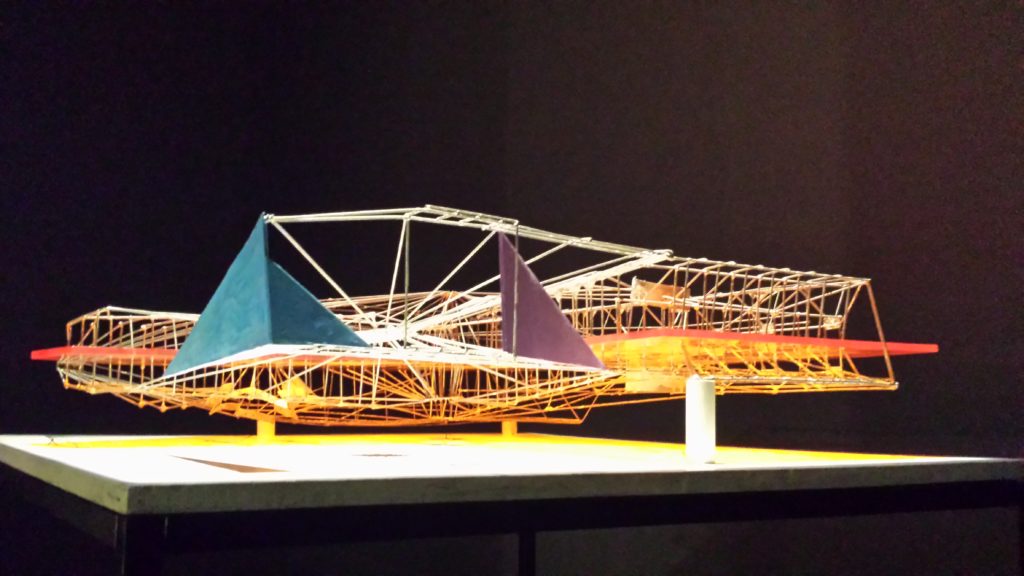
Ten years earlier, Dutch artist Constant Niewenhuys had begun envisioning his own “New Babylon” megastructure as a hopeful expression of Situationist ideas of unitary urbanism–in this case, infinitely reconfigurable environments meant to facilitate a new class of “homo-ludens”‡ to playfully define their surroundings, unifying art and life. McKenzie Wark, in her survey of the Situationists, The Beach Beneath the Street, measures the distance between Constant’s re-imagining of social order in space and the modernist visionary projects of the time–
Of all these seemingly utopian projects, Constant’s is the only one for which a transformation in built form can only come out of a transformation of social relations.
(Wark 2011, 145)
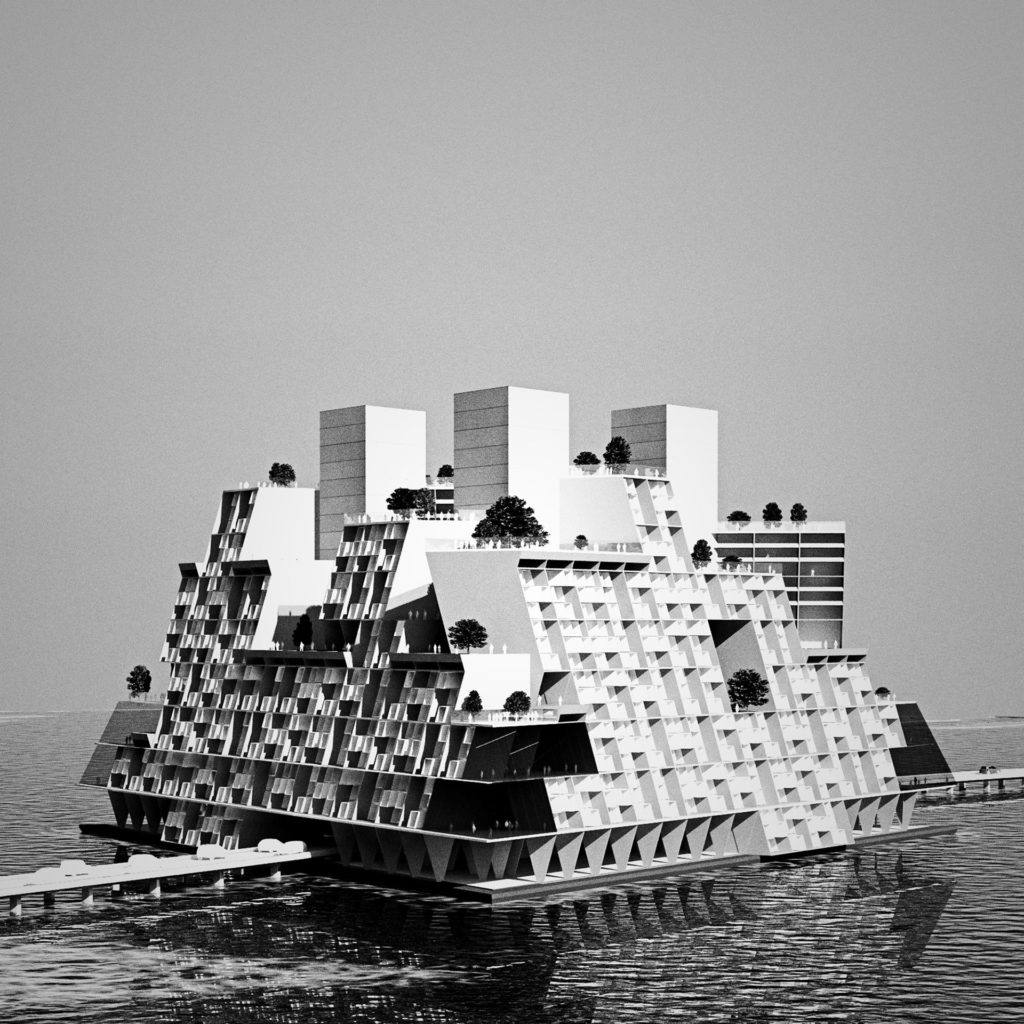
The idea of dense megastructures, already in the zeitgeist by way of groups like Archigram, had begun to receive a full-throated denunciation by the emerging new left. Constant himself was drummed-out of the Situationist International by founder Guy Debord, who had concluded that a prescriptive situationist mode of architecture was not possible§. Sociologist Jean Baudrillard called such projects the “chimera of utopia” (Austin and Soleri 1974, 32). The Arcologies and Megastructures of Constant and Soleri were overshadowed by a backlash against proposals like Buckminster Fuller’s atomic-powered floating Triton City and Old Man’s River City, which had been condemned by urban historian Lewis Mumford–
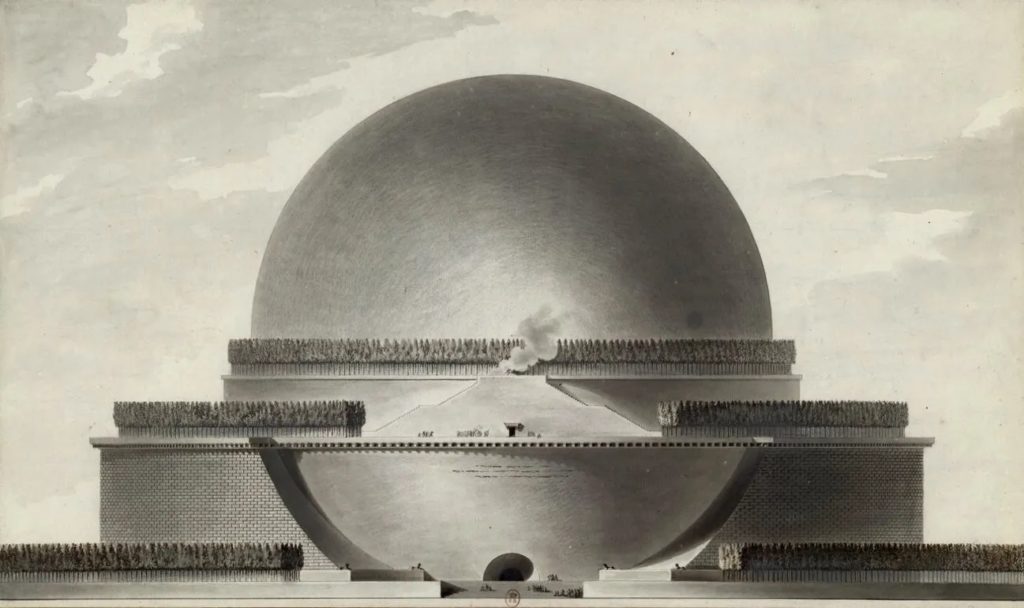
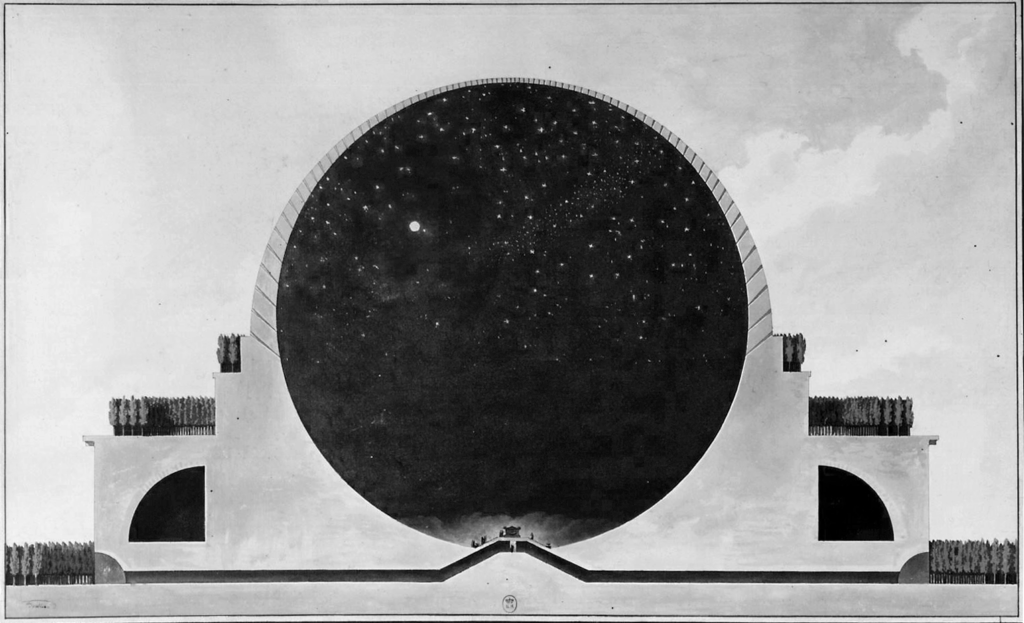
Whatever their superficial difference, all these projects are essentially tombs: They reflect the same impulse to suppress human variety and autonomy, and to make every need and impulse conform to the system of collective control imposed by the autocratic designer.
(Mumford 1971, 203)
–many critiques of Soleri’s visionary architecture condemned it thus as authoritarian even though Soleri, who had spent portions of his childhood living under fascism, argued ceaselessly that the arcology was a laboratory for the will of its residents, and that the structures should evolve to fit their needs and environmental requirements–
The laboratory is by definition that with which utopia cannot coexist. Utopia is conclusive if not conclusion itself. The laboratory is– instances and occasions streaming along the immense tide of those events reality is itself creating.
(Soleri 1984)
“Arcology” is also the final form that residential blocks take in SimCity 2000 (the second game in the series)– a componentized form of neighborhood that fits the maximum number of residents into the same Phoenix-style car-centric sprawl. This representation might have infuriated Soleri, who thought the car had enslaved North American society. Soleri’s designs flowed from a belief that suburbia was an “engine for consumption.” His designs were also connected to a complicated personal system of metaphysics that seemed situated in a new-age mentality, fixated on ideas of an interplay between interiority and exteriority. The parallel project of science-fiction worldbuilding promptly plundered Soleri’s forms without engaging with many of the ideas that prefigured them.
Disasters
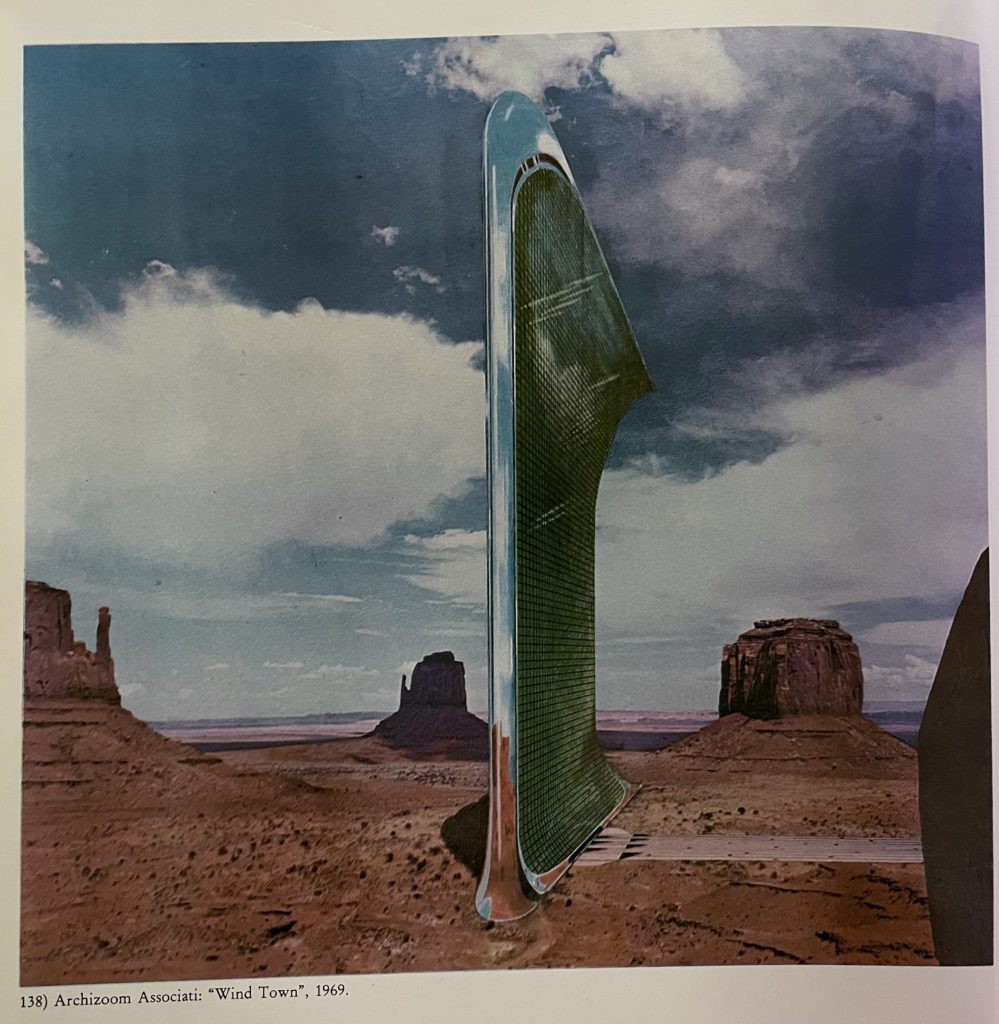
The term ‘Arcology’ has now survived Soleri mostly as a fixture in fictional dystopias, as in the corporate arcologies of William Gibson’s Neuromancer trilogy and the monumental pyramid that housed technocrat Elden Tyrell in the film Blade Runner. Blade Runner’s massive megastructure, set in earthquake-prone Los Angeles, seems precariously placed. Soleri, when asked what would happen to one of his dense urban structures if there were to be a powerful earthquake, admitted it would likely become a giant memorial (Soleri et al. 2017, 34). It’s hard to imagine the Blade Runner future springing from the Los Angeles we know now–a city that demands the dream of single-family homes and cars for all against any sort of reasonable counterargument. The film’s megastructures materialize 1980s racist anxieties of an encroaching Asian-ness, exaggerating the idea of large structures like the Wong Tai Sin public housing estates in earthquake-free Hong Kong into dense and intimidating ziggurats. The techno-orientalist shades of 80s cyberpunk gave outlet to US ruling class’s fears about the loss of personal freedom-from-restraint, either by an imagined Sino-scientific socialism or at the hands of a futuristic Japanese corporate feudalism that the United States had itself unwittingly unleashed. In these scenarios, the arcology always stands as a termite-mound symbol of doom–either a stronghold for the rich that cannot be entered, or a hive for a collectivized, oppressed human. During the pandemic, as I designed my dwarven megastructures, Western White fear-mongering about Asia reached a fever-pitch over rumored origins of, and starkly-contrasting state responses to, the novel coronavirus. The fear of being locked inside a megastructure is emblematic of individual and economic anxieties that cowed the United States into its haphazard and ineffective response to the spread of COVID.
Disasters are often an important part of simulation games. One of the pleasures of SimCity is unlocking “God” mode, revealing commands that unleash tornadoes, earthquakes and Godzilla-like monsters on one’s own creations. Games like SimCity, Populous and Civilization (barring multiplayer modes) allow save states–if the player makes a mistake, they can simply revert to a past save, avoiding the repercussions of their choices, creating a sort of branching quantum immortality common in digital games. Dwarf Fortress, lacking user-controlled save states#, has a way of emphasizing the narrative potential of catastrophe in a way that other simulation games do not. The game saves when quitting and does not provide a way of storing multiple saves, pushing the player to accept failures and tragedies as part of play, even to the point of civilizational collapse (the player community repeats “losing is fun!” as a mantra). A fortress where all citizens have starved or been murdered (or have abandoned the territory at the player’s admission of defeat) remains a persistent part of the game world. A ruined or abandoned fortress can be reclaimed by the player later, or left to the natural entropy of the simulation, adopted by herds of gazelle or families of foxes sniffing at your absconded dwarves’ scattered mismatched socks. If the player chooses, the situation that led to the fall of the civilization can be addressed with a new group of dwarves and new strategies, but there will likely be a big mess to clean up. Calamity in Dwarf Fortress is difficult to avoid, and during times of intense play over the course of the pandemic, I watched more than a few disasters unfold. One of my dwarven cities saw every adult dwarf slaughtered by a poisonous “forgotten beast” that I had foolishly provoked with a small militia. The monster, seemingly satisfied, retired to a body-strewn cave to rest, while the now-orphaned children of the fortress played unsupervised in its bloody hallways. Over the next few game days, an unattended library I had built on the surface of the city attracted fleets of visiting scholars, mathematicians, philosophers, and troupes of poets who socialized and collaborated on great works… as the orphans died of dehydration, one-by-one, in the structures beneath their feet. I no longer had any agency in the game world other than to watch as this grim spectacle played out.
In many ways, arcology as architecture is the chimera of a utopia, as Baudrillard warned–a quest towards the unattainable, solving a series of problems in such a way that new problems will almost certainly be created. The Arcology Mode of play serves as a laboratory for experimenting with these ways of thinking, as dangerous as they may be. The arcology, both in our hypothesized mode of play and in visionary architecture, is a symbol of a possible or impossible future, a dream of reorganization, of a new stability that is inevitably also an imagined community. Imagining a community means defining what turns strangers into kin, and as a result who is not included in that community (Anderson 2006). Imagining (often fictional) shared identities was a catalyst for social change in the past, trading one set of problems for another, building nationalism over the ruin of feudalism (with its own new host of cataclysmic problems). Social structures are already being built and negotiated all the time, however, regardless of whether they are enshrined within a futuristic walled city. To assume that design and architecture are alone the tools needed to address problems caused by violently-policed hierarchies is to build larger and larger facades to hide an ever-deepening pit.
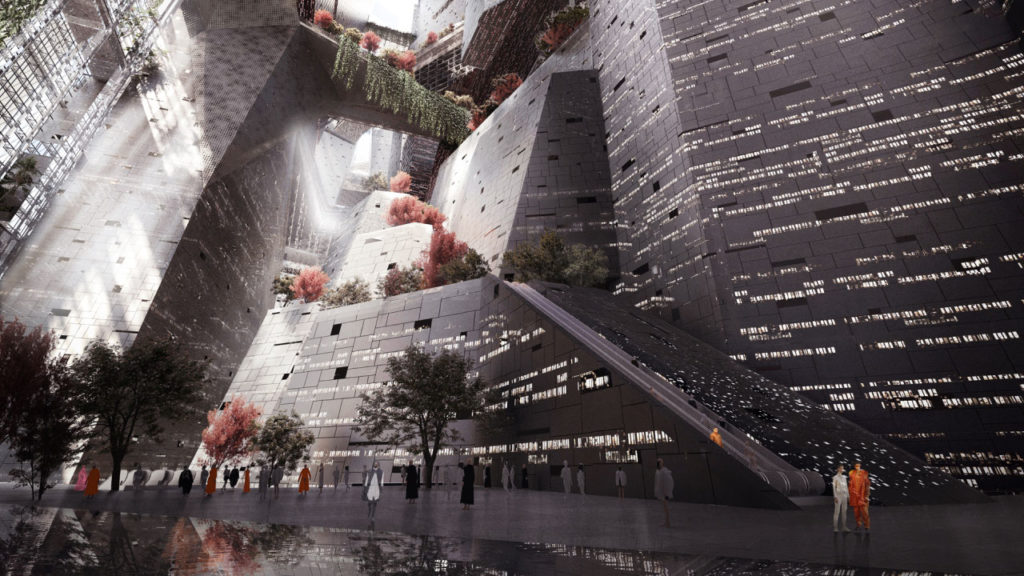
Arcology projects seek to design not just built forms and imagined communities; they describe the type of power that would be required to build them. What would it take to mobilize the massive amounts of labor required to build such a thing? What would those relationships look like? The Saudi state, a notorious human rights abuser**, is both an entity capable of building an arcology and perhaps the foremost candidate for who should not build one. One Twitter user left a well-placed “Thank you, slaves” meme from the show Wonder Showzen in the responses to the Saudi press release for The Line.
Twisting and distorting Soleri’s ideas into an enormous, solid, “invisible” wall surrounded by desert is a frighteningly apt symbol of a new eco-fascism that could be in store for our future. Efforts to reify such forms into the built environment should be met with an interrogation of the power that could build such a thing and a scientific analysis of the harms and benefits of such projects. Promises of sustainability and reduced environmental impact are part of the visionary hand-waving of these projects, but the bigger the vision, the bigger the suspicion that the shadow of that power will necessarily occlude our ability to accurately judge the results. Within the laboratory of the Arcology game mode, a strange light shines. The ability to radically reimagine power, self, society and the built environment seems like a daunting and doomed fiasco for an out-of-control id, but there are a multiplicity of ways to carry out such an exercise, as visionary play shows us. Redesigning the megastructure of power is the first great project that we must carry out if any projects that follow are to be just.
Works Cited
Anderson, Benedict R. O’G. 2006. Imagined Communities: Reflections on the Origin and Spread of Nationalism. Rev. ed. London ; New York: Verso.
Austin, Holcombe M., and Paolo Soleri. 1974. “Arcology: The City in the Image of Man.” The Journal of Aesthetics and Art Criticism 33 (1): 115. https://doi.org/10.2307/428967.
“DF2014:Dwarven Economy.” 2018. Dwarf Fortress WIki. July 18, 2018. https://www.dwarffortresswiki.org/index.php/DF2014:Dwarven_economy.
Fordyce, Robbie. 2018. “Dwarf Fortress: Laboratory and Homestead.” Games and Culture 13 (1): 3–19. https://doi.org/10.1177/1555412015603192.
Huizinga, Johan. 1971. “Homo Ludens: A Study of the Play-Element in Culture.” In Homo Ludens. Boston: Beacon Press.
Moore, Rowan. 2022. “Saudi’s 100-Mile Mega-City Is Meant to Blow Our Minds – so We Forget the Crimes of Its Rulers – Protesters against Neom Don’t Last Long. How Can Western Architects Ignore This?” Guardian, The: Web Edition Articles (London, England), October 23, 2022. Access World News – Historical and Current. https://infoweb.newsbank.com/apps/news/document-view?p=WORLDNEWS&docref=news/18D684081F953868.
Mumford, Lewis. 1971. The Pentagon of Power. Myth of the Machine / Mumford, Lewis, vol. 2. London: Secker and Warburg.
Pedercini, Paolo. 2017. “SimCities and SimCrises – International City Gaming Conference Keynote.” 2017. https://molleindustria.org/GamesForCities/.
Reuters. 2022. “Saudi Crown Prince Touts Vertical Living in NEOM’s Zero-Carbon City.” Reuters, July 26, 2022, sec. Disrupted. https://www.reuters.com/world/middle-east/saudi-crown-prince-touts-vertical-living-neoms-zero-carbon-city-2022-07-25/.
Soleri, Paolo, Claire C Carter, Larry Busbea, Garth Johnson, and Jonathon Keats Scottsdale Museum of Contemporary Art. 2017. Repositioning Paolo Soleri: The City Is Nature.
Twilley, Geoff Manaugh, Nicola. 2013. “The Philosophy of SimCity: An Interview With the Game’s Lead Designer.” The Atlantic. May 9, 2013. https://www.theatlantic.com/technology/archive/2013/05/the-philosophy-of-simcity-an-interview-with-the-games-lead-designer/275724/.
Wark, McKenzie. 2007. Gamer Theory. Cambridge, Mass: Harvard University Press.
Wark, McKenzie. 2011. The Beach Beneath the Street: The Everyday Life and Glorious Times of the Situationist International.
Wigley, Mark, and Constant. 1998. Constant’s New Babylon: The Hyper-Architecture of Desire. Rotterdam: Witte de With, Center for Contemporary Art : 010 Publishers.
- *The developers, Bay 12 Games, provide Dwarf Fortress as a free download, and have historically accepted donations to continue work. In December of 2022 they released commercial version that includes built-in graphics and a streamlined user interface (“Bay 12 Games: Dwarf Fortress” n.d.).
- †Coins can be minted, but a full currency economy mode brought about by the arrival of nobles was abandoned after it caused frequent community collapses in a previous version of the game (“DF2014:Dwarven Economy” 2018).
- ‡“Homo Ludens” is a term borrowed from Dutch philosopher/historian Johan Huizinga, who asserted in his text of the same name that, “civilization arises and unfolds in and as play” (Huizinga 1971).
- §This marked the end result of a quarrel that began when images of a church designed by collaborating Dutch architects were included in an issue of the journal Forum prepared by Constant, introducing the Situationist concept of Unitary Urbanism. The images of the church incensed Debord, who considered churches to be antithetical to the concept (Wigley and Constant 1998, 32).
- ¶Branzi, Andrea. “The Hot House : Italian New Wave Design / Andrea Branzi ; Foreword by Arata Isozaki ; [Translated from the Italian by C.H. Evans].” The Hot House : Italian New Wave Design, 1st MIT Press ed., MIT Press, 1984.
- #In the commercial version of the game, the game concedes more control over saving to the player, allowing for the option of saving different “timelines” of a world.
- **Three members of the Huwaitat tribe have already been sentenced to death by the Saudi government for protesting their forced eviction in the development of the NEOM area (Moore 2022)